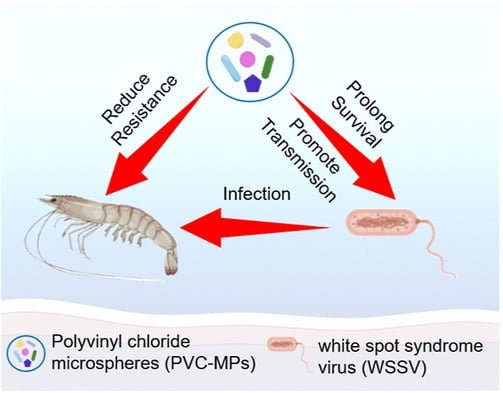
Plastic particles drifting in the ocean and rivers have become a danger to aquatic life. Aquatic organisms often ingest microplastic particles, mistaking them for food.
As the concentration of microplastics/microspheres (MP) increases in coastal regions and estuaries, concerns grow about the functioning of marine ecosystems and the likelihood of disease outbreaks and epidemics.
Microplastics accumulate in animals’ intestines, affecting growth and behavior.
Recent scientific reports suggest that their health might be further compromised, as plastics provide surfaces for a myriad of microorganisms, including disease-causing pathogens.
Scientists from Ningbo University, Ningbo Academy of Inspection and Quarantine, and Ningbo Customs District Technology Center investigated the impact of polyvinyl chloride microplastics (PVC-MP) on white spot syndrome virus (WSSV) infection in shrimp.
Impact of Microplastics on Shrimp Health
Recent studies have reported the toxic effects of microplastic accumulation in the tissues of vannamei shrimp, including their effects on behavior, tissues, enzymatic activity, and metabolome of these aquatic animals.
In laboratory experiments, Jiong Chen, Lei Liu, and their colleagues discovered that microplastics affected the host’s antiviral defense pathway, making them more vulnerable to viral infection.
“The results revealed that PVC-MP significantly increased WSSV replication in vivo, resulting in a high mortality rate among larvae and facilitating horizontal WSSV transmission,” they reported.
In the study, researchers observed that shrimp ingesting 100 µm microplastics were more likely to get infected than those exposed to 5 or 10 µm particles.
Interaction of PVC-MP and White Spot Virus
According to scientists, “Data from WSSV loads detected using qPCR, agarose gel electrophoresis, and flow cytometry approaches indicated that PVC-MP could interact with the virus to prolong WSSV survival and maintain virulence at different temperatures and pH values.”
Regarding host resistance, metabolomic and transcriptomic analyses showed that exposure to PVC-MP upregulated metabolic concentrations and gene expressions associated with phospholipid metabolism, which were linked to innate immunity responses.
This resulted in a significant decrease in shrimp resistance to WSSV infection.
Conclusion
Scientists from Ningbo University report that polyvinyl chloride microplastics prolong the survival and replication of white spot syndrome virus in shrimp larvae intestines, leading to a higher number of shrimp deaths.
“In general, these findings highlight that MPs promote shrimp susceptibility to WSSV in two aspects: host immune defense and viral virulence,” they concluded.
Ultimately, the study demonstrates how microplastics could impact the crustacean aquaculture industry, which already struggles to contain white spot syndrome virus outbreaks.
Reference
Li-Peng Shan, Yang Hu, Ling Hu, Han-Wei Liu, Lei Liu, and Jiong Chen. 2023. Involvement of Microplastics in the Conflict Between Host Immunity Defense and Viral Virulence: Promoting the Susceptibility of Shrimp to WSSV Infection. Environmental Science & Technology 2023 57 (31), 11634-11642 DOI: 10.1021/acs.est.3c01566

